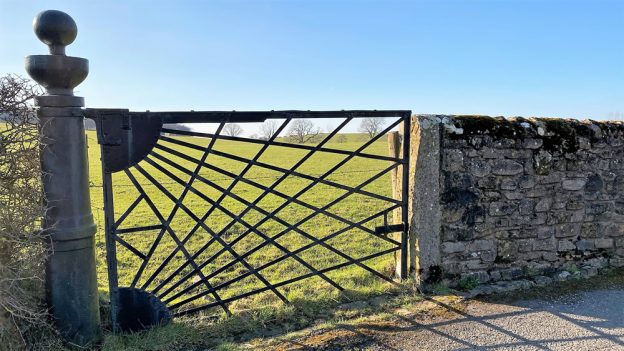Spider’s Web Gates
The Spider’s Web Gates were one of the iconic objects of my childhood. They stand at the entrance of the driveway to Clifford Hall, close to Burton-in-Lonsdale. Their design is unusual, unique and really out-of-character with the area. The Spider’s Web Gates were always more than just gates: it is as though their design was too strong to be just contained within wrought iron, and so leaked out into the mythology and landscape of the area. The locality around them became known as Spider’s Web. A walk through Greta Woods looping back to Burton via Clifford Hall is referred to as the Spider’s Web Walk. The stretch of road from Burton Bridge to Ravensclose is known locally as Spider’s Web Road. As a child I was told that touching the gates would give you bad luck. Being friendly with the Towler family (during the 1970s and 1980s) who lived at Clifford Hall, I had no option but to touch the gates to open and close them on a regular basis every time I cycled down to visit. I have probably accumulated a lot of bad luck as result of this.
I hadn’t really thought about the gates for a long time and then a lady contacted me about the Burton-in-Lonsdale pottery industry. In her email, she casually mentioned that her grandfather had made the Spider’s Web Gates in a blacksmiths in Burton-in-Lonsdale.
William (Henry Garnett) Slater was born in 1876. His father ran the smithy on Duke Street, Burton-in-Lonsdale. William worked and trained to be a blacksmith with his father and the Spider’s Web Gates were made by William during his apprenticeship. He was apparently very proud of the gates and quite rightly so to. This would date the gates to sometime in the 1890s. William also made the weather vane on top of the church spire and when the vane was taken down – not too long ago – for a clean, the name SLATER was found stamped on it.
A friend of mine pointed out that the gates are a listed building and sent me Craven District Council’s reference to this:
Gates to the south of Clifford Hall Cottages, Burton-in-Lonsdale SD 6470 7126 II 24 June 1988 Gates c. 1820. Cast iron and ashlar.
A pair of ashlar banded and rusticated gate piers surmounted by ball finials. A pair of cast iron gates with iron sun turrets from the top and bottom corners, with radiating iron spokes. These gates are very similar in design to those designed by Thomas Telford on the Holyhead Road, and might be after his design
This is very interesting for a number of reasons:
- If you Google Image search “Thomas Telford Gates”, you get lots of images of gates that bare an uncanny resemblance to the Spider’s Web Gates. I don’t think there can be any doubt that the gates were inspired by Thomas Telford’s design.
- The gates were not actually based on a spider’s web at all, but rather on a double sunburst pattern.
- The gates are dated to 1820. I suspect that Craven District Council estimated this based upon the building of Clifford Hall. However if this date is correct then William Slater cannot have made them, as this would be almost 60 years before he was born.
Thomas Telford’s sunburst gates were designed for the toll houses on the London to Holyhead road that was built between 1815 and 1826. If the Spider’s Web Gates were made in 1820, then they predate the completion of the road. Could the Spider’s Web Gates have a direct connection with Thomas Telford? Where they manufactured alongside the Holyhead gates?
The gate posts are cast iron. I doubt that a local blacksmith would have the facilities to cast something so large. The same friend that pointed out the listed building reference for the gates suggested that the posts resemble cannons – and the filial cannon balls and might be a reference to the Battle of Waterloo (1815). This seems a possibility (especially if they were built in 1820).
Personally I find it hard to believe that the Spider’s Web Gates are over 200 years old. I think the posts though may well be. My feelings are that the original gates (perhaps they were wooden) were looking a bit tired by the late 19th century and so the owner of Clifford Hall arranged for the local blacksmith to make him some new ones. Too many descendants of William Slater seem to confirm that he made the gates, for it to be a myth. I guess you could prove this theory by finding the SLATER stamp on the gates, although I suspect the gates may need to be sandblasted first. I will however definitely search for it next time I am passing. As to how the design was chosen, well that is anybody’s guess. Perhaps the owner of Clifford hall spent a lot of time travelling from Holyhead to London or maybe William Slater had a strong interest in prominent Scottish engineers?
Today, the Spider’s Web Gates are permanently locked open, which in my opinion is a great shame, as they make a far bolder statement closed when the strands/beams of the four radiating webs/suns meet up in the middle and create a more unified and homogenous whole.

